 |
Channel  : Programming : Programming
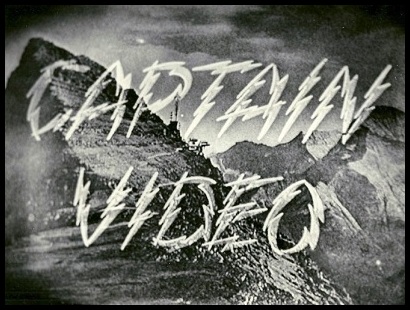
"One day, a baby elephant was going to appear on
Manhattan Spotlight. Meanwhile, Captain Video
was on the air. Suddenly, the elephant started
trumpeting...On the air, Captain Video stood up
and said, 'What the hell is that?' And the Ranger
said, 'I don't know, Captain, but get down, it
might be dangerous!'"
Wes Kenney, a former DuMont staff director,
in Jeff Kisseloff's The Box (see Channel 11).
There were many original DuMont network shows (see the Appendices),
but the DuMont network is not remembered as much for the quality of its
programming as it was for being clever with programming ideas on a low
budget. Jeff Kisseloff's excellent book The Box (see Channel 11) describes a late-night DuMont show called Monodrama Theater, which featured a single actor performing a monologue or play in front of a curtain. Night Editor starred Hal Burdick as the night editor of a newspaper, who acted out some of the stories he described. The Plainclothesman
depicted the action from the point of view of the main character, who
was never seen. (If he were hit in the jaw, for example, the camera
would shake.)
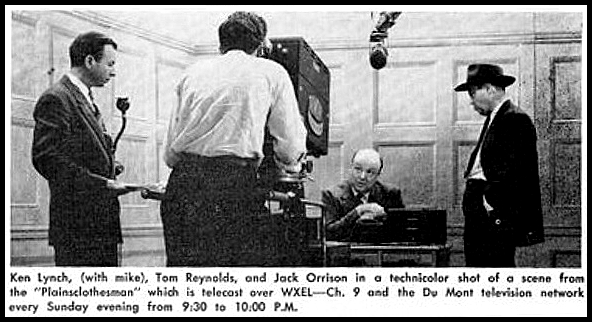
Such ingenuity is all the more remarkable when one
considers that the vast majority of DuMont's shows were "live" (or, at
best, kinescoped), without the luxury of re-takes or film editing. This
is also why, unlike other programs from the same era such as I Love Lucy, one is unlikely to see any DuMont shows in syndication today. (One Milwaukee TV station aired a kinescope of Rocky King, Detective in the 1980's, which is rather astonishing.)
After its first few years, DuMont's programs were never
highly-rated, although they presumably did better in markets like New
York and Washington where DuMont had a full-time VHF affiliate (or in
Pittsburgh, where DuMont had a monopoly). R.D. Heldenfels writes:
...success as defined by DuMont was exceedingly small;
after 1950 it never had a prime-time show among the
twenty-five most popular, let alone the top ten. Its last
show to rank that high was the variety series Cavalcade
of Stars in the 1949-50 season.
Referring to a 1951 program the author once viewed at the
Museum of Television and Radio in New York (described at the bottom of
this page), Heldenfels continues:
DuMont was a network that marked its twentieth
anniversary with a thirty-minute special done in a
few spartan sets. When the actor playing network
founder Allen B. DuMont said, "I've got $500 and
a place in my basement," viewers arriving late
may have thought he was talking about the show's
budget and location.
Some of the most popular and influential shows on the DuMont network were the previously mentioned Cavalcade of Stars, a variety show starring Jackie Gleason which gave birth to the Honeymooners (starring Pert Kelton as the original Alice Kramden); Life is Worth Living with Archbishop Fulton J. Sheen, the only show ever to achieve meaningful ratings against powerhouse Milton Berle on NBC; and Captain Video,
starring Richard Coogan (and later Al Hodge), a children's "space
opera" which was arguably the best-remembered and most popular show on
the network. Innovator Ernie Kovacs also did some programs for DuMont.
Other long-running shows on the DuMont network included Rocky King, Detective with Roscoe Karns, and the similarly-themed The Plainclothesman, starring Ken Lynch; Down You Go, a game show hosted by Dr. Bergen Evans; They Stand Accused, a courtroom drama from Chicago; and the Small Fry Club with Big Brother Bob Emery.
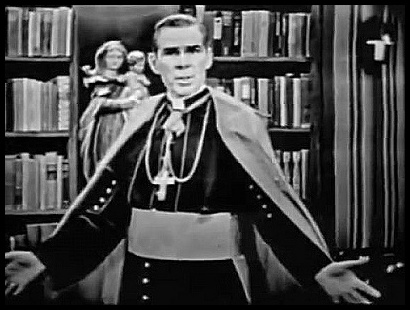
Bishop Fulton J. Sheen
In order to obtain clearances in Pittsburgh, the shows of
other networks were occasionally simulcast on DuMont. This was usually
accomplished by the sponsor purchasing the network's air time. Some
examples include the Admiral Broadway Revue in 1949 and Man Against Crime in
1953-54 (simulcast on NBC and DuMont), and the political coverage of
1952 (simulcast on CBS and DuMont, and sponsored by Westinghouse, which
was based in Pittsburgh and bought the time on DuMont to insure that
this coverage would be seen in its home market). In addition, hard as it
is to believe in today's competitive environment, some programs were
simulcast on all four networks (presumably at the behest of the
sponsor), including the East-Midwest coaxial cable opening (1/11/49),
the General Foods Anniversary Show (10/24/54), and a program called Light's Diamond Jubilee
(3/28/54), produced by David O. Selznick, celebrating the 75th anniversary of the invention of the light bulb!
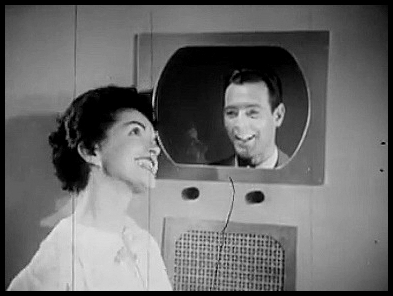
A scene from Light's Diamond Jubilee.
(The author tends to discount these as "DuMont shows",
since, in reality, these were the programs of other networks which were
merely simulcast on DuMont. Indeed, the author owns several Admiral Broadway Revue
kinescopes which identify NBC at the end, with no sign of DuMont.
Similarly, filmed programs which aired on DuMont are often difficult to
confirm, since many of them aired locally on DuMont stations long after
the network had folded. Moreover, most of these films, such as Public Prosecutor and Front Page Detective, were not specifically produced for DuMont. To the author, programs like Captain Video and Rocky King, Detective, which aired "live" and originated at DuMont's studio facilities, best represent the "true" DuMont lineup.)
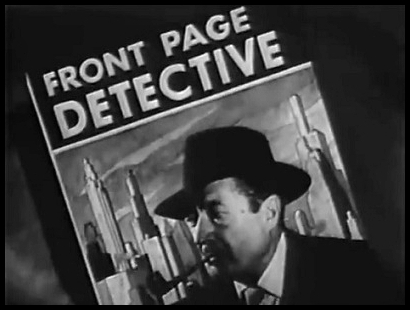
Many things could go wrong, and did, in those early days
of "live" television. The author's mother vividly recalled an episode of Rocky King, Detective
in which a character was killed, and then, unaware that the live camera
was still trained on him, proceeded to get up, brush himself off, and
walk offstage, in full view of the audience! (Much merriment apparently
ensued.) In the author's personal collection of DuMont shows, there is
hardly a one where a line isn't flubbed, a cue missed, a prop knocked
over or mishandled, or the monitor being used to film the kinescope
recording doesn't start to flicker. (One would think that DuMont, as a
manufacturer of TV sets, would have been able to rectify the latter
problem.)
DuMont's kinescopes were reportedly stored in an ABC
network warehouse until the 1970's. In a 1988 interview with the author,
Ted Bergmann stated that he had lost track of DuMont's film archives,
and expressed his hope that they "might still be out there, somewhere."
However, according to testimony given by performer Edie Adams at a
public hearing on Television and Video Preservation held in 1996 by the
Library of Congress, the fate of DuMont's kinescopes became painfully
clear when she tried to locate the DuMont shows produced by her husband,
Ernie Kovacs. Her testimony reads, in part:
I don't know what happened to the (Ernie Kovacs) CBS
shows, but have recently learned what happened to the
DuMont shows. That's the early Jackie Gleason
shows, including the original Honeymooners, Captain
Midnight (she probably meant Captain Video—ed.) and
the Kovacs specials. Well, they were taken care of in a
most unique and swift fashion.
In the earlier '70's, the DuMont network was being
bought by another company, and the lawyers were in
heavy negotiation as to who would be responsible for
the library of the DuMont shows currently being stored
at the facility, who would bear the expense of storing
them in a temperature controlled facility, take care of
the copyright renewal, et cetera.
One of the lawyers doing the bargaining said that he
could "take care of it" in a "fair manner," and he did
take care of it. At 2 a.m. the next morning, he had
three huge semis back up to the loading dock at ABC,
filled them all with stored kinescopes and 2" videotapes,
drove them to a waiting barge in New Jersey, took
them out on the water, made a right at the Statue of
Liberty and dumped them in the Upper New York Bay.
Very neat. No problem.
This flagrant, callous disregard for an irreplaceable part of television history is a rather sad postscript to the DuMont story.
Still, some DuMont kinescopes have survived across the
years. Indeed, since after only a few years there was no DuMont company
or network to preserve them, it is amazing that so many DuMont
kinescopes still exist. UCLA has over 300 DuMont network programs in
their film collection, and the Paley Center for Media, with
branches in New York City and Los Angeles, has some DuMont shows
available for public viewing, as does the Museum of Broadcast
Communications in Chicago. (The founder and president of MBC is Bruce
DuMont, the nephew of Allen B. DuMont.) One of Jackie Gleason's writers,
Snag Werris, stored dozens of kinescopes of DuMont's Cavalcade of Stars
in a closet for many years; when he died, his daughter donated the
films to the Paley Center, which made them available to the Disney Channel
for a series of specials. Finally, some DuMont shows are in the hands of collectors, and are available to purchase, or to watch and/or download on popular sites like YouTube and the Internet Archive.
(If you do visit the Paley Center, the author heartily
recommends viewing a program titled Passaic: Birthplace of Television
and the DuMont Story. This is a 15-minute teleplay depicting the history
of DuMont, with actors portraying Dr. DuMont and his associates, and
ending with a live shot of the good Doctor himself on the dais,
presumably being honored by the Passaic Chamber of Commerce or some such
organization. The author found this so charming that he watched it
numerous times in succession, and completely neglected his other
selections for the rest of the afternoon.)
Go to Channel 6: UHF
|
 |

